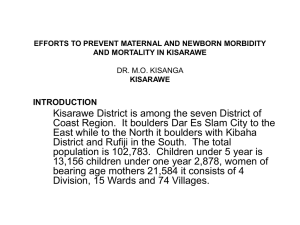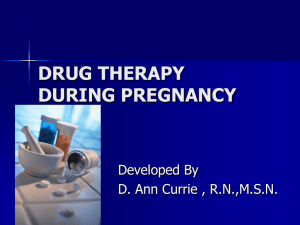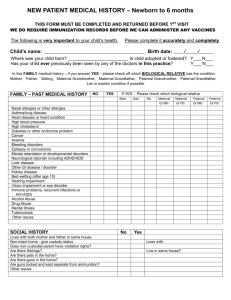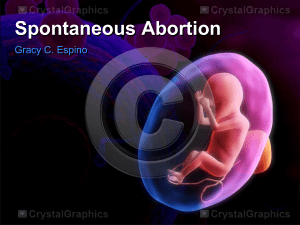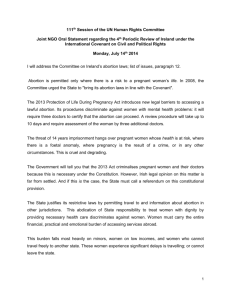Word DOCX
advertisement
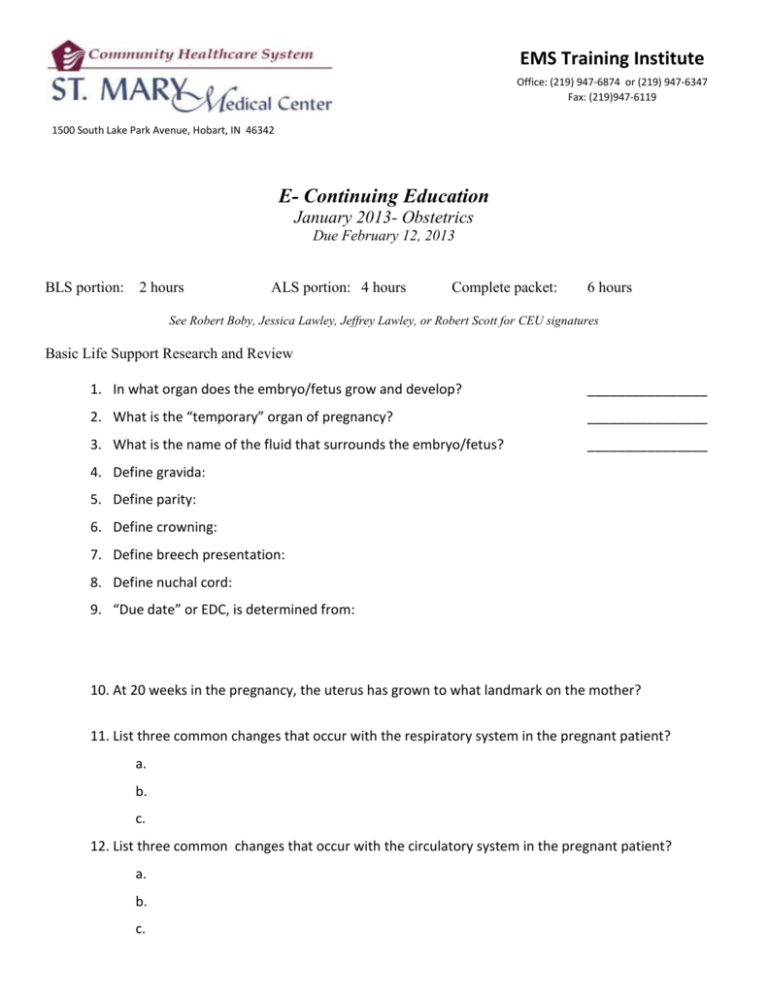
EMS Training Institute Office: (219) 947-6874 or (219) 947-6347 Fax: (219)947-6119 1500 South Lake Park Avenue, Hobart, IN 46342 E- Continuing Education January 2013- Obstetrics Due February 12, 2013 BLS portion: 2 hours ALS portion: 4 hours Complete packet: 6 hours See Robert Boby, Jessica Lawley, Jeffrey Lawley, or Robert Scott for CEU signatures Basic Life Support Research and Review 1. In what organ does the embryo/fetus grow and develop? ________________ 2. What is the “temporary” organ of pregnancy? ________________ 3. What is the name of the fluid that surrounds the embryo/fetus? ________________ 4. Define gravida: 5. Define parity: 6. Define crowning: 7. Define breech presentation: 8. Define nuchal cord: 9. “Due date” or EDC, is determined from: 10. At 20 weeks in the pregnancy, the uterus has grown to what landmark on the mother? 11. List three common changes that occur with the respiratory system in the pregnant patient? a. b. c. 12. List three common changes that occur with the circulatory system in the pregnant patient? a. b. c. 13. How can these changes impact the pregnant patient regarding presentation/detection of shock? a. b. c. d. e. 14. Post partum bleeding can be decreased by which three tactics? a. b. c. 15. First stage of labor begins with: 16. First stage of labor ends with: 17. Second stage of labor begins with: 18. Second stage of labor ends with: 19. Third stage of labor begins with: 20. Third stage of labor ends with: 21. Define pre-eclampsia: 22. Define eclampsia: 23. How does supine hypotensive syndrome occur? 24. How can we correct supine hypotensive syndrome? 25. What other patient population may supine hypotensive syndrome occur in, other than the pregnant patient? 26. How can we correct supine hypotensive syndrome in this patient population? Advanced Life Support Research and Review 1. What hormones are produced during the secretory phase (immediately following ovulation) to prepare the uterus for implantation? a. b. 2. What is the function of these two hormones? a. b. 3. In what location in the female body does fertilization usually occur? 4. Fertilization outside of this area is known as: 5. In what layer of the uterus does the fertilized egg implant? 6. The acronym “TPAL” is sometimes used to give more specific information that just G/P. What does it stand for? T P A L 7. Using TPAL, complete the history of the following patient: A woman is currently pregnant. She has delvered two children at term, one at 30 weeks, and had a spontaneous abortion at 16 weeks. There are 3 living children. T___P___A___L___ 8. The fertilized egg is referred to as a/an ____________ for the first eight weeks of pregnancy. 9. After the first eight weeks, it is referred to as a/an: 10. What is the approximate volume of amniotic fluid after the first 20 weeks? 11. List the main vessels (an number of each) within the umbilical cord: 12. Describe how the placenta functions as an endocrine gland: 13. Within the first trimester, maternal heart rate increases: 14. Explain the physiology changes that occur to the maternal heart in the first trimester: 15. What can this physiologic change show on the cardiac monitor? a. b. 16. By the end of the pregnancy, the maternal cardiac output has increased by what percentage? 17. By the end of pregnancy, the maternal blood volume has increased by what amount? 18. Fetal heart tones may be auscultated with a stethoscope after gestational age of ____ weeks. 19. Normal fetal heart tones range from ____ to ____. 20. Differentiate : Spontaneous abortion Pre-term birth 21. Complete the following: Complete abortion Incomplete abortion Threatened abortion Septic abortion Therapeutic abortion 22. Differentiate Placenta previa 23. Complete the following, as it relates to preeclampsia: Sign/symptoms 24. What medication, and dose, is often given for eclampsia-related seizures? Abruptio placenta Risk factors 25. List two infections that may pose little threat to the mother, but significant risk for birth defects for the fetus: a. b. 26. List three infections that pose significant risk for the mother and the fetus: a. b. c. 27. Explain chorioamnionitis: a. What are the two bacterial that most commonly cause this condition? i. ii. 28. Explain PROM: 29. Explain preterm PROM: 30. List five complications of maternal diabetes a. b. c. d. e. 31. Define the onset of labor: 32. Explain cervical dilation: 33. Explain cervical effacement: 34. The first stage of labor for the primiparous patient is about ___ hours 35. The first stage of labor for the multiparous patient is about ___ hours 36. The second stage of labor for the primiparous patient is about ___ minutes 37. The second stage of labor for the multiparous patient is about ___ minutes 38. Complete relating to normal delivery procedures/maneuvers: 1 2 3 4 5 6 39. Normal maternal blood loss with a vaginal delvery is ____ mL. 40. Differentiate between the types of breech positions: Frank breech Complete breech Footling breech 41. Explain shoulder dystocia: 42. Which maternal position may assist with this type of delivery? 43. Explain “turtle sign”: 44. Which type of fetal patient is this commonly seen? 45. Explain cephalopelvic disproportion: 46. Explain compound presentation: 47. Meconium is present in what percentage of deliveries: 48. What is the leading cause of death during preganancy? 49. Why is this the leading cause of death?



